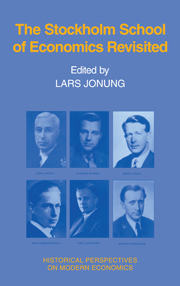Book contents
- Frontmatter
- Dedication
- Contents
- Preface
- List of Contributors
- Dramatis Personae at the end of 1937
- Introduction and Summary
- Part I The roots
- 1 The Political Economy Club and the Stockholm School, 1917–1951
- 2 Gösta Bagge, the Rockefeller Foundation, and empirical social science research in Sweden, 1924–1940
- 3 The Committee on Unemployment and the Stockholm School
- Part II The approach of the Stockholm School
- Part III The impact of the Stockholm School
- Part IV What remains of the Stockholm School?
- The Stockholm School: A non-Swedish bibliography
3 - The Committee on Unemployment and the Stockholm School
Published online by Cambridge University Press: 05 July 2013
- Frontmatter
- Dedication
- Contents
- Preface
- List of Contributors
- Dramatis Personae at the end of 1937
- Introduction and Summary
- Part I The roots
- 1 The Political Economy Club and the Stockholm School, 1917–1951
- 2 Gösta Bagge, the Rockefeller Foundation, and empirical social science research in Sweden, 1924–1940
- 3 The Committee on Unemployment and the Stockholm School
- Part II The approach of the Stockholm School
- Part III The impact of the Stockholm School
- Part IV What remains of the Stockholm School?
- The Stockholm School: A non-Swedish bibliography
Summary
The Committee on Unemployment was instrumental in creating the great interest in business cycle theory and monetary and fiscal policy in Sweden in the 1930s. The Committee (1927–35) engaged many economists, several of whom – Dag Hammarskjöld, Alf Johansson, Karin Kock, Erik Lindahl, Gunnar Myrdal, Bertil Ohlin, and Ingvar Svennilson – are today considered members of the Stockholm School. Thus the Committee played a crucial role in the development of the Stockholm School. Some of the most important works of the early Stockholm School were published as supplements to the reports of the Committee.
The purpose of this contribution is to examine one of the settings in which the Stockholm School developed and to present new information on the development of some of the ideas of the Stockholm School by using unpublished and previously nonutilized material from the Committee. The contributions to the Committee by Ernst Wigforss and Bertil Ohlin and the treatment of public works are chosen as examples.
The Committee on Unemployment
The Committee on Unemployment was appointed in April 1927, several years before the depression of the 1930s. The starting point was thus not the mass unemployment of the 1930s but the considerably lower unemployment rate of the second half of the 1920s.
The impetus for appointing a committee came from another committee – the Unemployment Committee of 1926 (1926 års Arbetslöshetssakkunniga) – which dealth with unemployment insurance and measures for helping the unemployed.
- Type
- Chapter
- Information
- The Stockholm School of Economics Revisited , pp. 103 - 124Publisher: Cambridge University PressPrint publication year: 1991
- 5
- Cited by

